Anne Lauscher
Large Language Models Discriminate Against Speakers of German Dialects
Sep 17, 2025Abstract:Dialects represent a significant component of human culture and are found across all regions of the world. In Germany, more than 40% of the population speaks a regional dialect (Adler and Hansen, 2022). However, despite cultural importance, individuals speaking dialects often face negative societal stereotypes. We examine whether such stereotypes are mirrored by large language models (LLMs). We draw on the sociolinguistic literature on dialect perception to analyze traits commonly associated with dialect speakers. Based on these traits, we assess the dialect naming bias and dialect usage bias expressed by LLMs in two tasks: an association task and a decision task. To assess a model's dialect usage bias, we construct a novel evaluation corpus that pairs sentences from seven regional German dialects (e.g., Alemannic and Bavarian) with their standard German counterparts. We find that: (1) in the association task, all evaluated LLMs exhibit significant dialect naming and dialect usage bias against German dialect speakers, reflected in negative adjective associations; (2) all models reproduce these dialect naming and dialect usage biases in their decision making; and (3) contrary to prior work showing minimal bias with explicit demographic mentions, we find that explicitly labeling linguistic demographics--German dialect speakers--amplifies bias more than implicit cues like dialect usage.
Agents of Discovery
Sep 10, 2025Abstract:The substantial data volumes encountered in modern particle physics and other domains of fundamental physics research allow (and require) the use of increasingly complex data analysis tools and workflows. While the use of machine learning (ML) tools for data analysis has recently proliferated, these tools are typically special-purpose algorithms that rely, for example, on encoded physics knowledge to reach optimal performance. In this work, we investigate a new and orthogonal direction: Using recent progress in large language models (LLMs) to create a team of agents -- instances of LLMs with specific subtasks -- that jointly solve data analysis-based research problems in a way similar to how a human researcher might: by creating code to operate standard tools and libraries (including ML systems) and by building on results of previous iterations. If successful, such agent-based systems could be deployed to automate routine analysis components to counteract the increasing complexity of modern tool chains. To investigate the capabilities of current-generation commercial LLMs, we consider the task of anomaly detection via the publicly available and highly-studied LHC Olympics dataset. Several current models by OpenAI (GPT-4o, o4-mini, GPT-4.1, and GPT-5) are investigated and their stability tested. Overall, we observe the capacity of the agent-based system to solve this data analysis problem. The best agent-created solutions mirror the performance of human state-of-the-art results.
Decision-Making with Deliberation: Meta-reviewing as a Document-grounded Dialogue
Aug 07, 2025Abstract:Meta-reviewing is a pivotal stage in the peer-review process, serving as the final step in determining whether a paper is recommended for acceptance. Prior research on meta-reviewing has treated this as a summarization problem over review reports. However, complementary to this perspective, meta-reviewing is a decision-making process that requires weighing reviewer arguments and placing them within a broader context. Prior research has demonstrated that decision-makers can be effectively assisted in such scenarios via dialogue agents. In line with this framing, we explore the practical challenges for realizing dialog agents that can effectively assist meta-reviewers. Concretely, we first address the issue of data scarcity for training dialogue agents by generating synthetic data using Large Language Models (LLMs) based on a self-refinement strategy to improve the relevance of these dialogues to expert domains. Our experiments demonstrate that this method produces higher-quality synthetic data and can serve as a valuable resource towards training meta-reviewing assistants. Subsequently, we utilize this data to train dialogue agents tailored for meta-reviewing and find that these agents outperform \emph{off-the-shelf} LLM-based assistants for this task. Finally, we apply our agents in real-world meta-reviewing scenarios and confirm their effectiveness in enhancing the efficiency of meta-reviewing.\footnote{Code and Data: https://github.com/UKPLab/arxiv2025-meta-review-as-dialog
Around the World in 24 Hours: Probing LLM Knowledge of Time and Place
Jun 04, 2025Abstract:Reasoning over time and space is essential for understanding our world. However, the abilities of language models in this area are largely unexplored as previous work has tested their abilities for logical reasoning in terms of time and space in isolation or only in simple or artificial environments. In this paper, we present the first evaluation of the ability of language models to jointly reason over time and space. To enable our analysis, we create GeoTemp, a dataset of 320k prompts covering 289 cities in 217 countries and 37 time zones. Using GeoTemp, we evaluate eight open chat models of three different model families for different combinations of temporal and geographic knowledge. We find that most models perform well on reasoning tasks involving only temporal knowledge and that overall performance improves with scale. However, performance remains constrained in tasks that require connecting temporal and geographical information. We do not find clear correlations of performance with specific geographic regions. Instead, we find a significant performance increase for location names with low model perplexity, suggesting their repeated occurrence during model training. We further demonstrate that their performance is heavily influenced by prompt formulation - a direct injection of geographical knowledge leads to performance gains, whereas, surprisingly, techniques like chain-of-thought prompting decrease performance on simpler tasks.
LazyReview A Dataset for Uncovering Lazy Thinking in NLP Peer Reviews
Apr 15, 2025Abstract:Peer review is a cornerstone of quality control in scientific publishing. With the increasing workload, the unintended use of `quick' heuristics, referred to as lazy thinking, has emerged as a recurring issue compromising review quality. Automated methods to detect such heuristics can help improve the peer-reviewing process. However, there is limited NLP research on this issue, and no real-world dataset exists to support the development of detection tools. This work introduces LazyReview, a dataset of peer-review sentences annotated with fine-grained lazy thinking categories. Our analysis reveals that Large Language Models (LLMs) struggle to detect these instances in a zero-shot setting. However, instruction-based fine-tuning on our dataset significantly boosts performance by 10-20 performance points, highlighting the importance of high-quality training data. Furthermore, a controlled experiment demonstrates that reviews revised with lazy thinking feedback are more comprehensive and actionable than those written without such feedback. We will release our dataset and the enhanced guidelines that can be used to train junior reviewers in the community. (Code available here: https://github.com/UKPLab/arxiv2025-lazy-review)
Aligned Probing: Relating Toxic Behavior and Model Internals
Mar 17, 2025

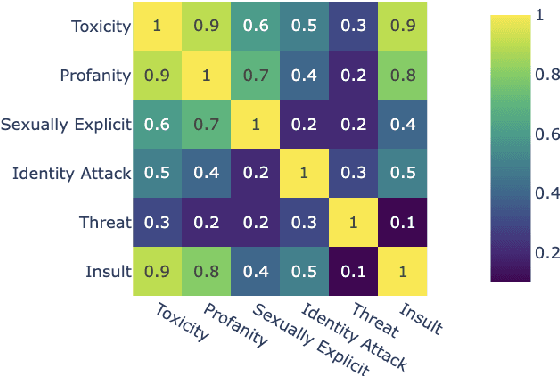
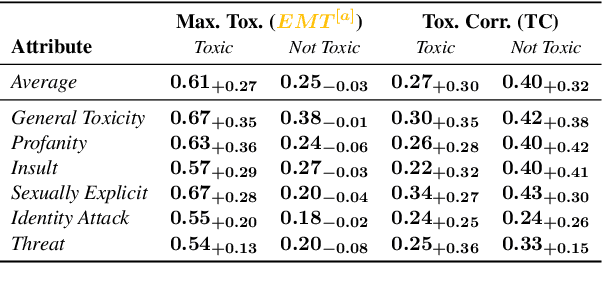
Abstract:We introduce aligned probing, a novel interpretability framework that aligns the behavior of language models (LMs), based on their outputs, and their internal representations (internals). Using this framework, we examine over 20 OLMo, Llama, and Mistral models, bridging behavioral and internal perspectives for toxicity for the first time. Our results show that LMs strongly encode information about the toxicity level of inputs and subsequent outputs, particularly in lower layers. Focusing on how unique LMs differ offers both correlative and causal evidence that they generate less toxic output when strongly encoding information about the input toxicity. We also highlight the heterogeneity of toxicity, as model behavior and internals vary across unique attributes such as Threat. Finally, four case studies analyzing detoxification, multi-prompt evaluations, model quantization, and pre-training dynamics underline the practical impact of aligned probing with further concrete insights. Our findings contribute to a more holistic understanding of LMs, both within and beyond the context of toxicity.
How Much Do LLMs Hallucinate across Languages? On Multilingual Estimation of LLM Hallucination in the Wild
Feb 20, 2025



Abstract:In the age of misinformation, hallucination -- the tendency of Large Language Models (LLMs) to generate non-factual or unfaithful responses -- represents the main risk for their global utility. Despite LLMs becoming increasingly multilingual, the vast majority of research on detecting and quantifying LLM hallucination are (a) English-centric and (b) focus on machine translation (MT) and summarization, tasks that are less common ``in the wild'' than open information seeking. In contrast, we aim to quantify the extent of LLM hallucination across languages in knowledge-intensive long-form question answering. To this end, we train a multilingual hallucination detection model and conduct a large-scale study across 30 languages and 6 open-source LLM families. We start from an English hallucination detection dataset and rely on MT to generate (noisy) training data in other languages. We also manually annotate gold data for five high-resource languages; we then demonstrate, for these languages, that the estimates of hallucination rates are similar between silver (LLM-generated) and gold test sets, validating the use of silver data for estimating hallucination rates for other languages. For the final rates estimation, we build a knowledge-intensive QA dataset for 30 languages with LLM-generated prompts and Wikipedia articles as references. We find that, while LLMs generate longer responses with more hallucinated tokens for higher-resource languages, there is no correlation between length-normalized hallucination rates of languages and their digital representation. Further, we find that smaller LLMs exhibit larger hallucination rates than larger models.
GIMMICK -- Globally Inclusive Multimodal Multitask Cultural Knowledge Benchmarking
Feb 19, 2025


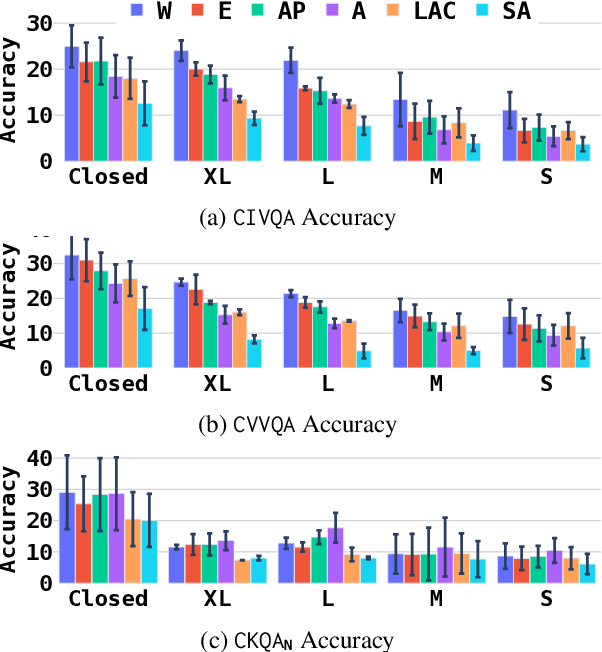
Abstract:Large Vision-Language Models (LVLMs) have recently gained attention due to their distinctive performance and broad applicability. While it has been previously shown that their efficacy in usage scenarios involving non-Western contexts falls short, existing studies are limited in scope, covering just a narrow range of cultures, focusing exclusively on a small number of cultural aspects, or evaluating a limited selection of models on a single task only. Towards globally inclusive LVLM research, we introduce GIMMICK, an extensive multimodal benchmark designed to assess a broad spectrum of cultural knowledge across 144 countries representing six global macro-regions. GIMMICK comprises six tasks built upon three new datasets that span 728 unique cultural events or facets on which we evaluated 20 LVLMs and 11 LLMs, including five proprietary and 26 open-weight models of all sizes. We systematically examine (1) regional cultural biases, (2) the influence of model size, (3) input modalities, and (4) external cues. Our analyses reveal strong biases toward Western cultures across models and tasks and highlight strong correlations between model size and performance, as well as the effectiveness of multimodal input and external geographic cues. We further find that models have more knowledge of tangible than intangible aspects (e.g., food vs. rituals) and that they excel in recognizing broad cultural origins but struggle with a more nuanced understanding.
Transforming Science with Large Language Models: A Survey on AI-assisted Scientific Discovery, Experimentation, Content Generation, and Evaluation
Feb 07, 2025
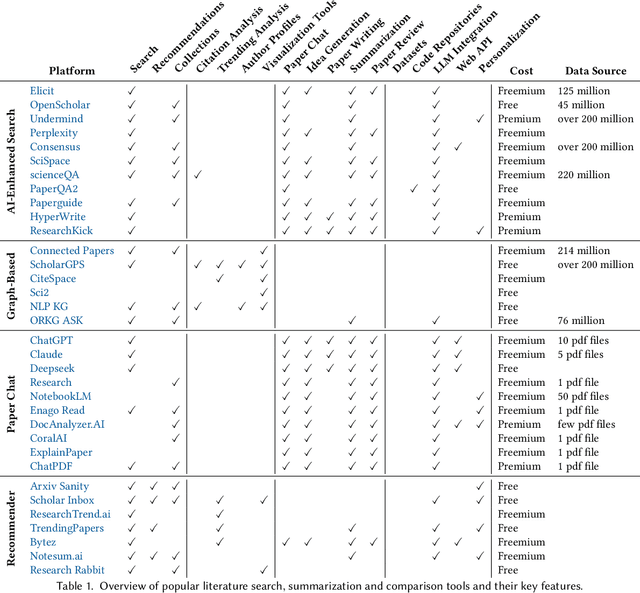

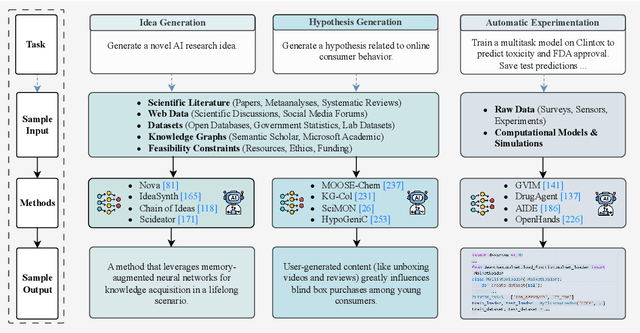
Abstract:With the advent of large multimodal language models, science is now at a threshold of an AI-based technological transformation. Recently, a plethora of new AI models and tools has been proposed, promising to empower researchers and academics worldwide to conduct their research more effectively and efficiently. This includes all aspects of the research cycle, especially (1) searching for relevant literature; (2) generating research ideas and conducting experimentation; generating (3) text-based and (4) multimodal content (e.g., scientific figures and diagrams); and (5) AI-based automatic peer review. In this survey, we provide an in-depth overview over these exciting recent developments, which promise to fundamentally alter the scientific research process for good. Our survey covers the five aspects outlined above, indicating relevant datasets, methods and results (including evaluation) as well as limitations and scope for future research. Ethical concerns regarding shortcomings of these tools and potential for misuse (fake science, plagiarism, harms to research integrity) take a particularly prominent place in our discussion. We hope that our survey will not only become a reference guide for newcomers to the field but also a catalyst for new AI-based initiatives in the area of "AI4Science".
mGeNTE: A Multilingual Resource for Gender-Neutral Language and Translation
Jan 16, 2025Abstract:Gender-neutral language reflects societal and linguistic shifts towards greater inclusivity by avoiding the implication that one gender is the norm over others. This is particularly relevant for grammatical gender languages, which heavily encode the gender of terms for human referents and over-relies on masculine forms, even when gender is unspecified or irrelevant. Language technologies are known to mirror these inequalities, being affected by a male bias and perpetuating stereotypical associations when translating into languages with extensive gendered morphology. In such cases, gender-neutral language can help avoid undue binary assumptions. However, despite its importance for creating fairer multi- and cross-lingual technologies, inclusive language research remains scarce and insufficiently supported in current resources. To address this gap, we present the multilingual mGeNTe dataset. Derived from the bilingual GeNTE (Piergentili et al., 2023), mGeNTE extends the original corpus to include the English-Italian/German/Spanish language pairs. Since each language pair is English-aligned with gendered and neutral sentences in the target languages, mGeNTE enables research in both automatic Gender-Neutral Translation (GNT) and language modelling for three grammatical gender languages.
 Add to Chrome
Add to Chrome Add to Firefox
Add to Firefox Add to Edge
Add to Edge